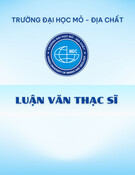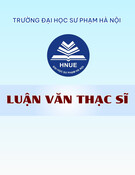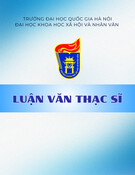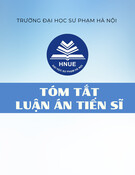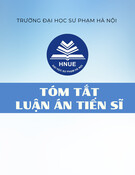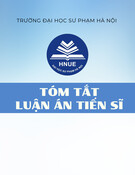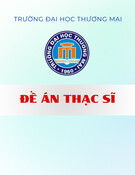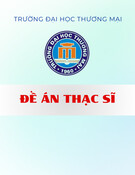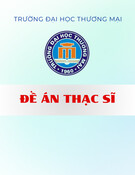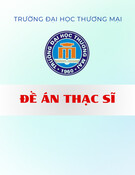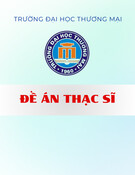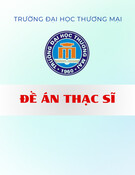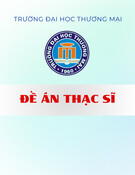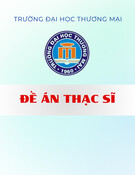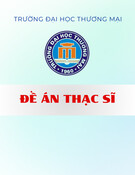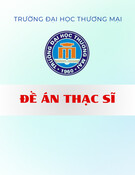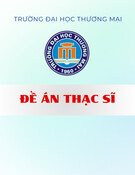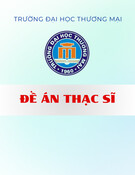
1
1
INTRODUCTION
1. Reasons for choosing the topic
1.1. Communication is the foundation of relationships, which is necessary
premise for the formation and development of psychology, personality of any
students in language process. For high school students in learning foreign
language learning process, strengthening their communicative competence to
develop foreign language is more significant and helps learners integrate with
foreigners and boost the efficiency of the students' foreign language learning
process.
1.2. Foreign language retardation in high school students causes many
troubles in the issue of language reception and expression, in understanding
foreign language (English), which can lead to less effective results in the
learners’ language perception. A great number of nations in the world have
taken different measures to improve communicative competence such as: the
development of coherence speech, the development of vocabulary, the ability
to understand the meaning of words, the ability to comprehend the
grammatical structure and the ability to pronounce correctly. Choosing the
measures of improving communicative competence for high school students
in foreign language learning process in specific and practical conditions in
Vietnam is one of the problems posed for solving by the thesis.
1.3. Foreign language communicative competence of high school students in
Vietnam have not been studied widely and systematically from detection with
specific tools in order to determine the level of development of the ability of
reception and expression, to specific skills in the phase of communication;
Educational measures to improve these high school students’ competences in
the global with specific economic, social and cultural traits that should be
solved in the thesis.
Research topic "Developing communicative competence in foreign
language teaching and learning process for high school students through
experiential approach", if successful, will help the teachers and educators
have the support measures so that high school students can develop their
foreign language communicative competence best.
2. Purpose of the study
On the basis of theoretical and real research, a wide range of activities are
proposed to effectively develop communicative competence in foreign
language teaching and learning process for high school students through
experiential approach.

2
3. Object and subject of the research
3.1. Object of the research: The process of educating foreign languages for
high school students.
3.2. Subject of the research: The development of communicative competence
for high school students in teaching and learning foreign language process
through experiential approach.
4. Scientific hypothesis: The communicative competence (CC) of high school
students (HSS) and the development of CC for HSS through experiential
approach (EA) in teaching and learning Foreign Language process (TLFLP) are
still limited. If proposing and applying methods to develop reasoning through EA
in the direction of well preparing conditions and enhance experiential activities
(including: enhancing HS to observe, increasing the use of problem situations,
increasing the use of simple scientific experiments, increasing the use of projects
scientific discoveries and increasing the use of learning games), the CC of HSS
will be improved.
5. Missions and scope of the research
5.1. Missions of the research
5.1.1. Researching the theoretical basis of developing CC for HSS through
experiential activities.
5.1.2. Researching the current situation of developing CC for HSS through
experiential activities.
5.1.3. Develop measures to enhance CC for HSS through experiential
activities.
5.1.4. Pedagogical experiment of methods to develop CC for HSS through
experiential activities proposed.
5.2. Scope of the research
5.2.1. Content:
The research distinguishes the norms of communicative language competence
(CLC), rather than communicative competence in developing CC for HSS’s
learning foreign language process. Also, based on experiential learning
process designed by David. A.Kolb, the thesis aims to develop CLC in TLFLP
for HSS through EA.
5.2.2. Location and time
- Directly survey 394 HSS and 127 principals, educators and English
teachers at 07 high schools in Hanoi, including: Kim Lien, Hecmann
Gmeiner, Trung Gia, Phan Huy Chu, Dong Da, Tay Ho and Nguyen Thi Minh
Khai High Schools from the school year 2015 -2016 to the second term of the year
2018-2019.

3
- In-depth study/Case study by 2 cases HSS is applied measures to improve
CLC in the direction of the topic hypothesis in high schools in Hanoi.
6. Approach and research methods
6.1. Approach methods: The study is conducted according to the following
approaches: (1) Approaching education through experience; (2) Approaching
competence; (3) Approaching the system (structural approach - system); (4)
Approaching activities; (5) Approaching reality.
6.2. Research methods: The thesis uses theoretical research methods;
Practical research methods (Pedagogical observation; Conversation;
Investigation; Case study; Expert method; Pedagogical experiment method)
and Mathematical statistical method.
7.2. Research methods
7.2.1. Group of theoretical research methods
7.2.2. Group of practical research methods
(1) Survey method by questionnaire; (2) Deep interview; (3) Observe; (4)
Method of using the check table (checklist); (5) Work product research; (6)
Pedagogical empirical method.
7.2.3. Group of supplementary method
8. The arguments of the thesis that requires to be defended
- Developing CLC for HSS through EA will help the HSS interact and
communicate with each other both at school and in real life.
- The development of CLC for HSS through EA at high school has not
been concerned reasonably in both theoretical and practical conditions (E.g.
There is lack of theory, less common EA; many communication skill groups
done by both teachers and students are limited).
- In order to improve CLC for HSS through EA, there should be built a
foreign language teaching and learning process through EA, which may have
impact on high school students’ awareness, learning methods and
motivations.
- If the foreign language teaching and learning process through EA is
carried out reasonably in foreign language class, we can surely improve
foreign language learning quality for HSS in general and improve their CLC
in particular. The HSS’s motivations will therefore be raised as well.
9. New contributions of the thesis
9.1. About Reasoning
- Enriching reasoning theory of CLC development for HSS through EA,
contributing to the development of the theory of the path and ways to
positively impact EA development of HSS.

4
- Detecting some problems of CLC development for HSS through EA in
the current high school program, in awareness and organization, guiding EA of
teachers and the level of expression of CLC development for HSS through EA.
9.2. About practices
- The situation of CLC development of HSS through EA in language and
educating English for these students at 07 high schools in Hanoi was
described, analyzed, assessed on the basis of a rating ladder with 20 specific
criteria into 5 groups of basic language skills built exclusively for HSS.
- Proposing a foreign language teaching and learning process through
EA for developing CLC development of HSS through EA effectively.
Furthermore, an experiment of measures 1 and 2 has been done, showing the
efficiency and reality of the measures suggested.
- The content of the thesis are important materials as the basis for the
construction of training materials for teachers, managers are currently
working at high school; At the same time is a source of reference for the
lecturers, students of universities and colleges which train high school
teachers.
10. Layout of the thesis
In addition to the introduction, conclusion and recommendation, the thesis
consists of 04 chapters:
Chapter 1: The theoretical basis of developing communicative language
competence in teaching and learning foreign language process through
experiential approach for high school students.
Chapter 2: The situation of developing communicative language competence
in teaching and learning foreign language process through experiential
approach for high school students.
Chapter 3: Organizing the activities of developing communicative language
competence in teaching and learning foreign language process through
experiential approach for high school students.
Chapter 4: Experimental professionality.

5
CHAPTER 1: THEORETICAL BASIS ON DEVELOPING
COMMUNICATIVE COMETENCE IN TEACHING AND LEARNING
FOREIGN LANGUAGE PROCESS FOR HIGH SCHOOL STUDENTS
THROUGH EXPERIENTIAL APPROACH
1.1. Overview of research issues
Most of the deep research focuses on the formation and development of
language; In terms of development characteristics, the necessary conditions,
content, methods, forms for language development; research on
communicative competence in teaching and learning foreign language process
through experiential approach for high school students. This study goes
deeper in developing verbal communicative language competence in teaching
and learning foreign language process through experiential approach for high
school students in an inclusive education environment.
1.2. Some basic concepts
Concepts such as: (1) Competence; (2) Communicative Competence; (3)
Communicative Language Competence; (4) Communicative Language
Competence in teaching and learning foreign language process; (5)
Experiential approach and (6) Developing communicative language
competence in teaching and learning foreign language process through
experiential approach for high school students has been elucidated.
1.3. Reasoning on teaching and learning foreign language process and
communicative language competence in teaching and learning English as a
foreign language in general educational program for high school students
1.3.1. The roles, meanings and goals of developing communicative language
competence in teaching and learning foreign language process through
experiential approach for high school students
CLC meets the needs of cognition, eagerness to learn and discover of HSS; help
HSS develop skills such as observation, comparison, conjecture...; help them
expand vocabulary and enhance their ability to express in spoken language; allow
HSS to use existing premises for reasoning; help HSS to know how to test known
premises to make appropriate conclusions; create opportunities for HSS to
manipulate directly with diverse materials with all senses, helping their senses and
perceptions develop and become more sensitive.
1.3.2. The nature of developing CLC in teaching and learning foreign
language process (TLFLP) for HSS through EA
- Developing CLC in TLFLP for HSS through EA is understood as the process
of educating HSS in TLFLP so that HSS can actively think and apply their

